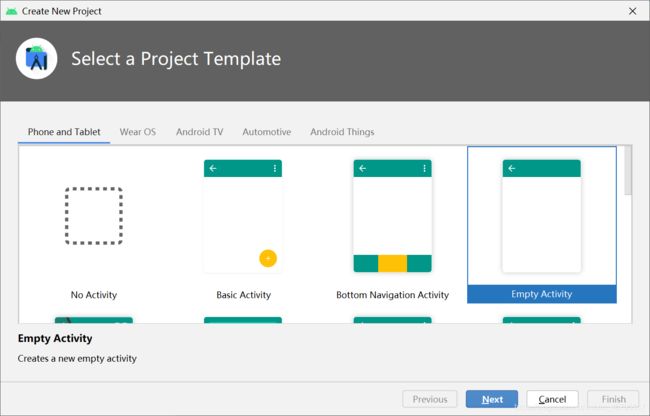Android学习记录(二十一)
文章目录
- TelephonyManager(电话管理器)
-
- 1.如何获得TelephonyManager的服务对象
- 2.案例演示
-
- 2.1 调用拨号器拨打电话号码
- 2.2 获取Sim卡信息与网络信息
-
- (1)新建项目
- (2)activity_main.xml
- (3)MainActivity.java
- (4)AndroidManifest.xml
- 2.3 获取手机信号强度
-
- 主要代码
- 2.4 监听手机的所有来电
-
- 运行效果
- 2.5 黑名单来电自动挂断
TelephonyManager(电话管理器)
获得其他app的Context,而这个Context代表访问该app的全局信息的接口,而决定应用的唯一标识 是应用的包名,所以我们可以通过应用包名获得对应app的Context 另外有一点要注意的是:其他应用的SP文件是否能被读写的前提就是SP文件是否指定了可读或者 可写的权限,我们上面创建的是MODE_PRIVATE的就不可以了
1.如何获得TelephonyManager的服务对象
TelephonyManager tManager = (TelephonyManager)getSystemService(Context.TELEPHONY_SERVICE);
2.案例演示
2.1 调用拨号器拨打电话号码
Uri uri=Uri.parse("tel:"+电话号码);
Intent intent=new Intent(Intent.ACTION_DIAL,uri);
startActivity(intent);
2.2 获取Sim卡信息与网络信息
(1)新建项目
(2)activity_main.xml
<LinearLayout xmlns:android="http://schemas.android.com/apk/res/android"
xmlns:tools="http://schemas.android.com/tools"
android:layout_width="match_parent"
android:layout_height="match_parent"
android:orientation="vertical"
android:padding="5dp"
tools:context=".MainActivity">
<TextView
android:id="@+id/tv_phone1"
android:layout_width="match_parent"
android:layout_height="wrap_content"
android:textSize="20sp" />
<TextView
android:id="@+id/tv_phone2"
android:layout_width="match_parent"
android:layout_height="wrap_content"
android:textSize="20sp" />
<TextView
android:id="@+id/tv_phone3"
android:layout_width="match_parent"
android:layout_height="wrap_content"
android:textSize="20sp" />
<TextView
android:id="@+id/tv_phone4"
android:layout_width="match_parent"
android:layout_height="wrap_content"
android:textSize="20sp" />
<TextView
android:id="@+id/tv_phone5"
android:layout_width="match_parent"
android:layout_height="wrap_content"
android:textSize="20sp" />
<TextView
android:id="@+id/tv_phone6"
android:layout_width="match_parent"
android:layout_height="wrap_content"
android:textSize="20sp" />
<TextView
android:id="@+id/tv_phone7"
android:layout_width="match_parent"
android:layout_height="wrap_content"
android:textSize="20sp" />
<TextView
android:id="@+id/tv_phone8"
android:layout_width="match_parent"
android:layout_height="wrap_content"
android:textSize="16sp" />
<TextView
android:id="@+id/tv_phone9"
android:layout_width="match_parent"
android:layout_height="wrap_content"
android:textSize="20sp" />
LinearLayout>
(3)MainActivity.java
public class MainActivity extends AppCompatActivity {
private TextView tv_phone1;
private TextView tv_phone2;
private TextView tv_phone3;
private TextView tv_phone4;
private TextView tv_phone5;
private TextView tv_phone6;
private TextView tv_phone7;
private TextView tv_phone8;
private TextView tv_phone9;
private TelephonyManager tManager;
private String[] phoneType = {
"未知","2G","3G","4G"};
private String[] simState = {
"状态未知","无SIM卡","被PIN加锁","被PUK加锁",
"被NetWork PIN加锁","已准备好"};
@Override
protected void onCreate(Bundle savedInstanceState) {
super.onCreate(savedInstanceState);
setContentView(R.layout.activity_main);
//①获得系统提供的TelphonyManager对象的实例
tManager = (TelephonyManager) getSystemService(Context.TELEPHONY_SERVICE);
bindViews();
}
private void bindViews() {
tv_phone1 = (TextView) findViewById(R.id.tv_phone1);
tv_phone2 = (TextView) findViewById(R.id.tv_phone2);
tv_phone3 = (TextView) findViewById(R.id.tv_phone3);
tv_phone4 = (TextView) findViewById(R.id.tv_phone4);
tv_phone5 = (TextView) findViewById(R.id.tv_phone5);
tv_phone6 = (TextView) findViewById(R.id.tv_phone6);
tv_phone7 = (TextView) findViewById(R.id.tv_phone7);
tv_phone8 = (TextView) findViewById(R.id.tv_phone8);
tv_phone9 = (TextView) findViewById(R.id.tv_phone9);
tv_phone1.setText("设备编号:" + tManager.getDeviceId());
tv_phone2.setText("软件版本:" + (tManager.getDeviceSoftwareVersion()!= null?
tManager.getDeviceSoftwareVersion():"未知"));
tv_phone3.setText("运营商代号:" + tManager.getNetworkOperator());
tv_phone4.setText("运营商名称:" + tManager.getNetworkOperatorName());
tv_phone5.setText("网络类型:" + phoneType[tManager.getPhoneType()]);
tv_phone6.setText("设备当前位置:" + (tManager.getCellLocation() != null ? tManager
.getCellLocation().toString() : "未知位置"));
tv_phone7.setText("SIM卡的国别:" + tManager.getSimCountryIso());
tv_phone8.setText("SIM卡序列号:" + tManager.getSimSerialNumber());
tv_phone9.setText("SIM卡状态:" + simState[tManager.getSimState()]);
}
}
(4)AndroidManifest.xml
<uses-permission android:name="android.permission.ACCESS_COARSE_LOCATION"/>
<uses-permission android:name="android.permission.READ_PHONE_STATE"/>
2.3 获取手机信号强度
网络信号强度的单位是dBm(毫瓦分贝),一般用负数表示,正常手机信号变化范围是从-110dBm (差)到-50dBm(好)之间。
手机获取信号强度代码示例:
dBm =-113+2*asu这是一个固定公式,asu(独立信号单元)
主要代码
MainActivity.java
public class MainActivity extends AppCompatActivity {
private TextView tv_rssi;
private MyPhoneStateListener mpsListener;
private TelephonyManager tManager;
@Override
protected void onCreate(Bundle savedInstanceState) {
super.onCreate(savedInstanceState);
setContentView(R.layout.activity_main);
tManager = ((TelephonyManager)getSystemService(Context.TELEPHONY_SERVICE));
tv_rssi = (TextView) findViewById(R.id.tv_rssi);
mpsListener = new MyPhoneStateListener();
tManager.listen(mpsListener,290);
}
private class MyPhoneStateListener extends PhoneStateListener {
private int asu = 0,lastSignal = 0;
@Override
public void onSignalStrengthsChanged(SignalStrength signalStrength) {
asu = signalStrength.getGsmSignalStrength();
lastSignal = -113 + 2 * asu;
tv_rssi.setText("当前手机的信号强度:" + lastSignal + " dBm" );
super.onSignalStrengthsChanged(signalStrength);
}
}
}
AndroidManifest.xml
<uses-permission android:name="android.permission.READ_PHONE_STATE"/>
2.4 监听手机的所有来电
思路:
重写TelephonyManager的一个通话状态监听器PhoneStateListener 然后调用TelephonyManager.listen()的方法进行监听,当来电的时候, 程序就会将来电号码记录到文件中!
实现代码:
MainActivity.java:
public class MainActivity extends Activity
{
TelephonyManager tManager;
@Override
public void onCreate(Bundle savedInstanceState)
{
super.onCreate(savedInstanceState);
setContentView(R.layout.main);
// 取得TelephonyManager对象
tManager = (TelephonyManager)
getSystemService(Context.TELEPHONY_SERVICE);
// 创建一个通话状态监听器
PhoneStateListener listener = new PhoneStateListener()
{
@Override
public void onCallStateChanged(int state, String number)
{
switch (state)
{
// 无任何状态
case TelephonyManager.CALL_STATE_IDLE:
break;
case TelephonyManager.CALL_STATE_OFFHOOK:
break;
// 来电铃响时
case TelephonyManager.CALL_STATE_RINGING:
OutputStream os = null;
try
{
os = openFileOutput("phoneList", MODE_APPEND);
}
catch (FileNotFoundException e)
{
e.printStackTrace();
}
PrintStream ps = new PrintStream(os);
// 将来电号码记录到文件中
ps.println(new Date() + " 来电:" + number);
ps.close();
break;
default:
break;
}
super.onCallStateChanged(state, number);
}
};
// 监听电话通话状态的改变
tManager.listen(listener, PhoneStateListener.LISTEN_CALL_STATE);
}
}
AndroidManifest.xml
<uses-permission android:name="android.permission.READ_PHONE_STATE"/>
运行效果
注意!要让这个程序位于前台哦!用另一个电话拨打该电话,接着就可以在DDMS的file Explorer的应用 对应包名的files目录下看到phoneList的文件了,我们可以将他导出到电脑中打开,文件的大概内容如下:
THR Oct 30 12:05:48 GMT 2014 来电: 137xxxxxxx
2.5 黑名单来电自动挂断
下面只显示一部分比较主要的代码
MainActivity.java
public class MainActivity extends Activity {
private TelephonyManager tManager;
private PhoneStateListener pListener;
private String number;
private EditText locknum;
private Button btnlock;
public class PhonecallListener extends PhoneStateListener
{
@Override
public void onCallStateChanged(int state, String incomingNumber) {
switch(state)
{
case TelephonyManager.CALL_STATE_IDLE:break;
case TelephonyManager.CALL_STATE_OFFHOOK:break;
//当有电话拨入时
case TelephonyManager.CALL_STATE_RINGING:
if(isBlock(incomingNumber))
{
try
{
Method method = Class.forName("android.os.ServiceManager")
.getMethod("getService", String.class);
// 获取远程TELEPHONY_SERVICE的IBinder对象的代理
IBinder binder = (IBinder) method.invoke(null,
new Object[] {
TELEPHONY_SERVICE });
// 将IBinder对象的代理转换为ITelephony对象
ITelephony telephony = ITelephony.Stub.asInterface(binder);
// 挂断电话
telephony.endCall();
}catch(Exception e){
e.printStackTrace();}
}
break;
}
super.onCallStateChanged(state, incomingNumber);
}
}
@Override
protected void onCreate(Bundle savedInstanceState) {
super.onCreate(savedInstanceState);
setContentView(R.layout.activity_main);
locknum = (EditText) findViewById(R.id.locknum);
btnlock = (Button) findViewById(R.id.btnlock);
//获取系统的TelephonyManager管理器
tManager = (TelephonyManager) getSystemService(TELEPHONY_SERVICE);
pListener = new PhoneStateListener();
tManager.listen(pListener, PhoneStateListener.LISTEN_CALL_STATE);
btnlock.setOnClickListener(new OnClickListener() {
@Override
public void onClick(View v) {
number = locknum.getText().toString();
}
});
}
public boolean isBlock(String phone)
{
if(phone.equals(number))return true;
return false;
}
}
AndroidManifest.xml
<uses-permission android:name="android.permission.CALL_PHONE" />
<uses-permission android:name="android.permission.READ_PHONE_STATE" />



